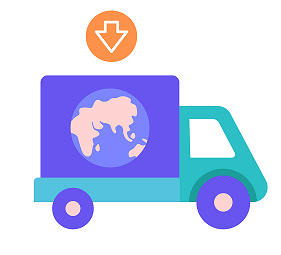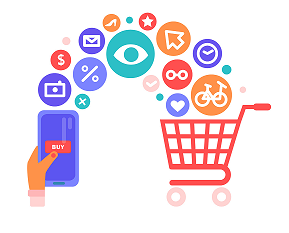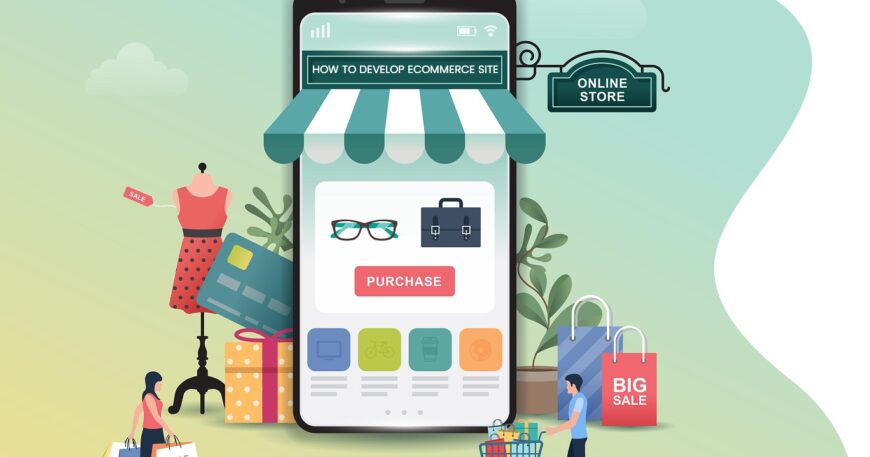E-commerce has transformed the way businesses operate, allowing them to buy and sell products/services online through websites, mobile apps, and digital platforms. The popularity of E-commerce has skyrocketed in recent years, with a significant increase in active users engaging in online shopping.
According to Forbes.com, E-commerce is projected to represent 20.4% of global retail sales by the end of 2022, doubling its market share in just five years. With the industry becoming more competitive, now is the perfect time to create your own E-commerce website platform with Web Tech.
 Let us walk you through the complete process of developing an Ecommerce website platform for your business.
Let us walk you through the complete process of developing an Ecommerce website platform for your business.
1. Choose the Right Name and Domain Selecting a relevant domain name is vital for branding and success. Opt for a name closely connected to your offerings and utilize descriptive keywords for better SEO rankings. Use domain registrar services like GoDaddy, Bluehost, or Google Domains to find and purchase an available domain. Aim for a .com extension, but .net and .co are also viable options.
2: Pick Your E-commerce Platform Web Tech offers various E-commerce platforms, including free and customizable ones like WordPress, Wix, and Shopify. Dedicated E-commerce platforms such as Big Commerce, Shopify, and Shift4Shop provide robust features like secure payments, shipping support, and multichannel sales. Choose the one that aligns with your business needs and goals.
Step 3: Plan and Build Your E-commerce Website Create a captivating logo and compelling brand imagery. Showcase your products with high-quality photos and videos, detailed descriptions, and various options (size, color, etc.). Include your unique story to connect with customers and establish trust. Provide excellent customer service with clear shipping rates, returns policy, and privacy information.

4: Set Up Payment, Tax, Shipping, and Marketing Tools Integrate payment processing solutions like Square, PayPal, or Stripe into your E-commerce platform for hassle-free transactions. Configure sales tax rates based on your state and sales volume. Streamline order fulfillment by connecting your E-commerce platform with shipping software. Utilize marketing tools to boost sales and customer engagement.
5: Test and Launch Your E-commerce Website Before going live, thoroughly test your website for functionality and user-friendliness. Ensure it supports multiple languages and currencies for a global audience. Protect your data with robust security measures. Once everything is in place, launch your E-commerce website and start selling!
Three top dedicated e-commerce platforms to consider include:
- Big Commerce: Big Commerce is geared to multichannel sellers and perhaps the most expandable small business e-commerce platform. Plans start at $29.95 per month.
- Shopify: Shopify is the most popular dedicated e-commerce platform and ideal for startups and drop-shippers. Shopify plans start at $29 per month.
- Shift4Shop: Shift4Shop is another top contender in the dedicated e-commerce platform field and offers a budget startup plan for just $19 per month.
All of these dedicated e-commerce platforms offer a free trial period, so you can test-drive each of them completely risk-free before deciding which one you’ll use.
Website builders with e-commerce features
Popular website builders Wix, Weebly and Squarespace all offer e-commerce functionality. If you already run a website on one of these platforms, you can add online sales features by simply moving to an e-commerce plan.
- Wix: Wix offers hundreds of beautiful, easy-to-use website templates with e-commerce features starting at $23 per month.
- Weebly: Similar to Wix, you can quickly and easily create a beautiful site on Weebly with e-commerce features for $25 per month.
- Squarespace: E-commerce features start at $30 per month and you can choose from hundreds of design templates.
Simplicity makes website builder platforms popular with the DIY and side-gig crowd. However, if you’re building a website with the intent to grow, a dedicated e-commerce platform delivers more integrated sales and marketing features for similar costs.
However major of these platforms comes with pre-defined templates and little customization and localization needs by the businesses.
3.Plan and build your e-commerce website
You’ll need to gather the following elements and information to create your business website:
Logo and brand imagery
All e-commerce platforms let you create a simple type logo, or you can use a third party platform like Canva to create your own logo using free logo templates.
Product photos, descriptions and data
Consider this checklist of information to include on your website, plus a few tips to help you market products effectively:
- Great product photos: You can capture great product photos with a little creativity and a cell phone camera. Be sure to take photos from several angles and show your products in use, if possible.
- Product videos: Authentic, real-world videos are proven sales tools, and you can also capture these with your cell phone.
- Detailed product descriptions: Create great product descriptions that cover every detail. Include the size, weight and material for each product you sell and add answers to frequently asked questions. Use keywords in product titles and descriptions where it makes sense to achieve search engine ranking.
- Product options: Options like size and color are called variables, and e-commerce platforms let you create multiple variables for items that come in different sizes, colors, etc.
- Product SKUs: Make sure you have your internal stock keeping units, or SKUs, plus any manufacturer’s codes on-hand. Sometimes buyers will search using a manufacturer’s code, so these are good to include in product data.
- Product pricing: Many e-commerce platforms give you single-item and group pricing options, plus sale and discount pricing. Some even let you track your product costs for reporting.
- Item size and weight: E-commerce platforms use item size and weight to determine real-time shipping costs and to print labels. This is optional, but can be a handy timesaver that automates your shipping process.
- Inventory: Insert a stock amount for each item and your e-commerce platform will track your inventory as products sell down.
Your story
This is your chance to connect with potential buyers, so make the “About Us” section of your website sing. Share your personal journey and embellish it with photos and videos and make it entertaining and engaging to keep buyers coming back for more.

Customer service pages
Great customer service keeps shoppers coming back, so use the customer service page of your e-commerce website to clearly set expectations. Key elements here include:
- Shipping rates and times:
State your typical shipping turn-around, the rates you charge and average delivery times.
- Returns and exchanges
Cover your returns policy and clearly state who pays for return shipping.
- Privacy policy:
By law, you must include a privacy policy on your website and most e-commerce platforms provide a blanket statement that you can insert.
User-friendly navigation
Your e-commerce website menus help shoppers easily navigate your website content. Most platforms let you create a main menu bar, along with footer menus and sometimes top and sidebar menus. Experiment to see which combination works best for your product collection and content.
4.Set up payment, tax, shipping and marketing tools
This step will vary depending on your e-commerce platform. All-in-one solutions like Big Commerce and Shopify come complete with built-in payment processing, tax calculations, shipping label printing and marketing tools. Most others require integrating a few outside services to handle these tasks.

Payment processing and tax table setup
All of the e-commerce website platforms covered above offer plug-and-play integration with top payment services like Square, PayPal and Stripe. To enable payment processing using these solutions, you simply click a few buttons, set up your account and you’re connected.
Most platforms also let you connect your own payment gateway and merchant account. However, built-in and plug-and-play payment services are the simplest, and often the most economical, options for startups.
After setting up your payment processor, you’ll configure sales tax rates to be collected from shoppers. All e-commerce website platforms support sales tax collection and let you apply taxes to select or all items and orders. The sales tax rates you charge depend on your state and, in most cases, your overall sales volume.
Shipping setup
You can, and should, integrate shipping software with your e-commerce platform to streamline the order fulfilment process. Integrated shipping seamlessly connects orders to shipping software so you can select carriers and shipping methods, print labels and automatically notify customers when their orders ship.

Big Commerce, Shopify and Woo Commerce all offer built-in shipping, so the integration is already done for you and setup takes just minutes. Most other platforms require that you connect a third-party solution like Ship Station or Shipping Easy to print labels and trigger customer notifications. These integrations work well with most platforms, but can add monthly costs.
5.Test and launch your e-commerce website
How many products I can showcase?
Our infrastructure management approach is holistic, addressing capacity monitoring, data storage, network utilization, asset lifecycles, software patching, wired and wireless networking and more. And with increasing demand for more sustainability in their setups.

Will my site support multiple languages and currencies?
Our infrastructure management approach is holistic, addressing capacity monitoring, data storage, network utilization, asset lifecycles, software patching, wired and wireless networking and more. And with increasing demand for more sustainability in their setups.
Where will all my data be stored and protected?
Our infrastructure management approach is holistic, addressing capacity monitoring, data storage, network utilization, asset lifecycles, software patching, wired and wireless networking and more. And with increasing demand for more sustainability in their setups.
Which technology will be used to development my Ecommerce Website?
Our infrastructure management approach is holistic, addressing capacity monitoring, data storage, network utilization, asset lifecycles, software patching, wired and wireless networking and more. And with increasing demand for more sustainability in their setups.

Partner with Web Tech for E-commerce Success Web Tech, your reliable partner in E-commerce website platform development, can help your business thrive in the digital world. We specialize in profitable E-commerce website design, development, and customization services. Our team of E-commerce experts offers guidance and consultation to ensure your success in just three easy steps.
Contact Details To learn more about Web Tech India’s quality assurance services for websites and web applications, visit the website at or email them at connect use this Mali id use this number +91-9974250782 info@bestwebsitedevelopmentcompany.in



